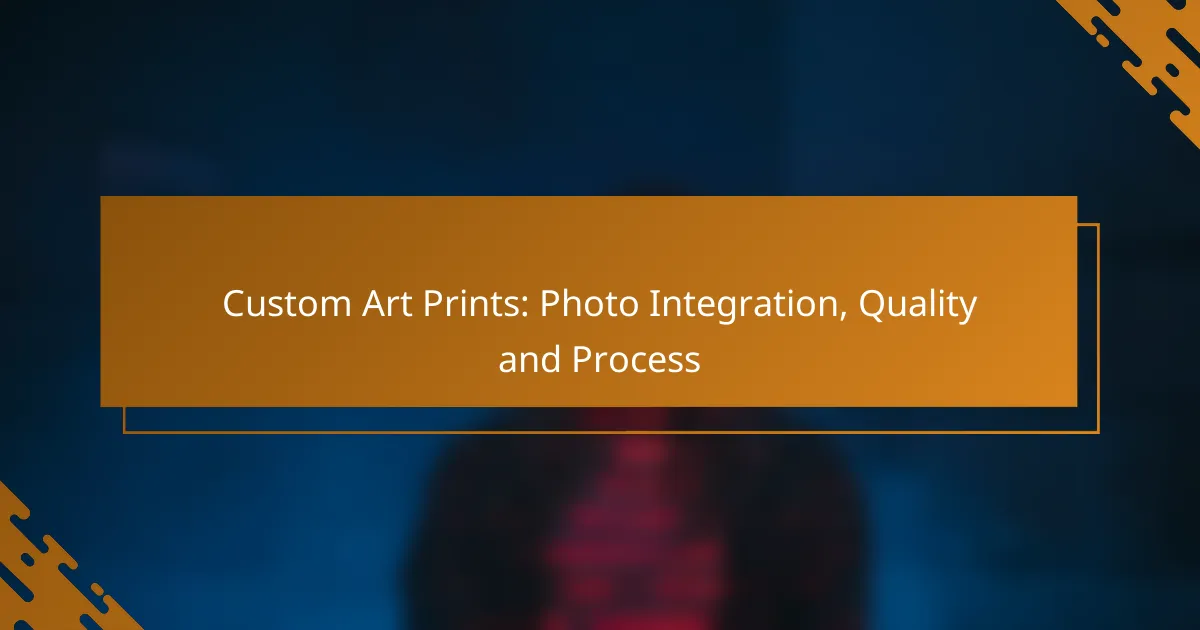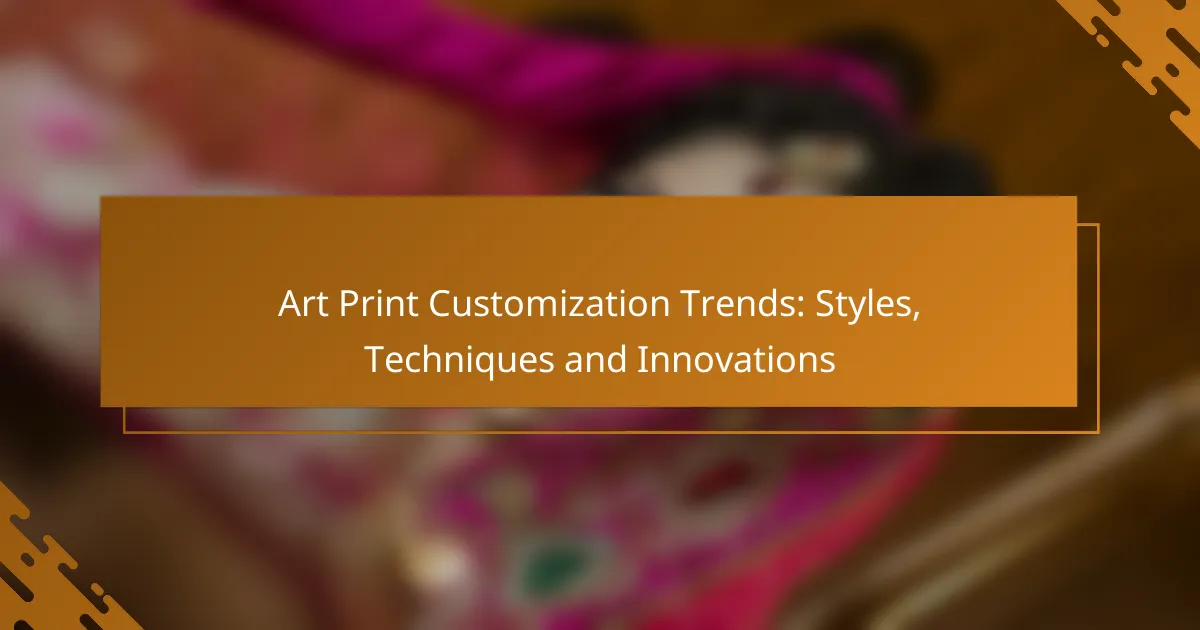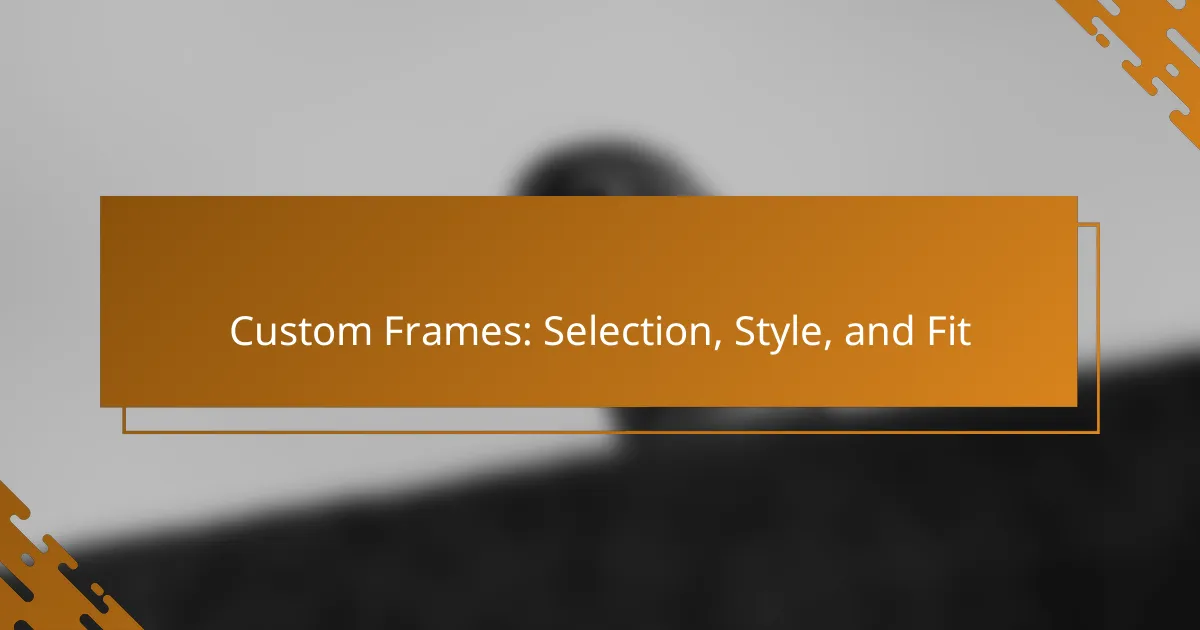Custom art prints offer a unique way to integrate personal photos into stunning artwork, allowing for a personalized touch that reflects individual style. The process involves careful selection and editing of images, ensuring high print resolution and color accuracy for a final product that meets quality standards. By understanding the steps involved in ordering, customers can streamline their experience and achieve beautiful, lasting prints.

How to integrate photos into custom art prints?
Integrating photos into custom art prints involves selecting digital images, editing them for quality, and using design templates to create a cohesive final product. This process allows for personalization while ensuring that the artwork meets desired aesthetic standards.
Digital photo uploads
To start integrating photos into custom art prints, users typically upload their digital images through an online platform. Most services accept common file formats like JPEG and PNG, with size limits often ranging from a few megabytes to several dozen megabytes per image.
When uploading, ensure that the resolution is high enough for printing, usually at least 300 DPI (dots per inch) for clear, sharp images. Low-resolution images may result in pixelation and a lack of detail in the final print.
Photo editing options
Many custom art print services offer built-in photo editing tools that allow users to enhance their images before finalizing the print. Common features include cropping, adjusting brightness and contrast, and applying filters or effects.
Consider using these editing options to improve the overall look of your photo. However, be cautious not to over-edit, as excessive filters can detract from the original image’s quality and authenticity.
Design templates for integration
Design templates provide a structured way to incorporate photos into custom art prints, ensuring a balanced and visually appealing layout. Most platforms offer a variety of templates tailored for different styles, such as modern, classic, or minimalist.
When selecting a template, consider how your photos will interact with other design elements. Ensure that the template complements the images rather than overwhelming them. This can enhance the overall impact of the print and create a more cohesive piece of art.
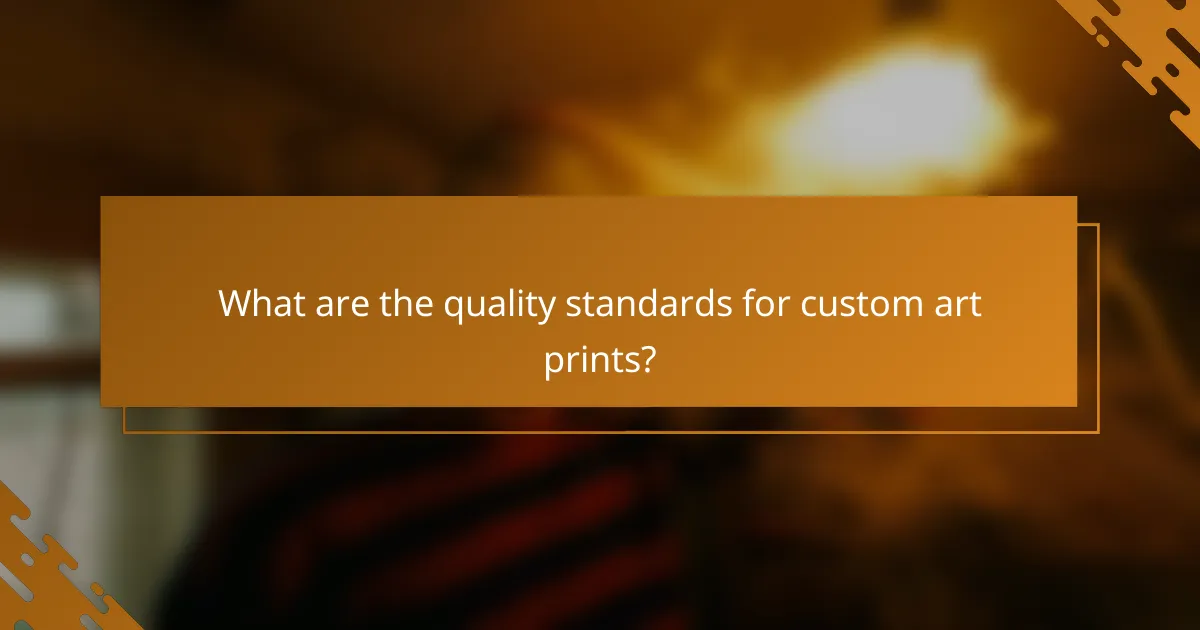
What are the quality standards for custom art prints?
Quality standards for custom art prints focus on print resolution, material quality, and color accuracy. These factors determine the overall appearance and longevity of the prints, ensuring they meet customer expectations and artistic intent.
Print resolution specifications
Print resolution is measured in dots per inch (DPI), with higher DPI values indicating finer detail. For high-quality art prints, a resolution of at least 300 DPI is recommended to capture intricate details and textures.
When selecting images for printing, ensure they are of sufficient resolution. For example, an image intended for a 16×20 inch print should ideally be at least 4800×6000 pixels to maintain clarity and sharpness.
Material quality comparisons
The choice of material significantly impacts the durability and aesthetic of custom art prints. Common materials include canvas, fine art paper, and photo paper, each offering different textures and finishes.
Canvas prints are known for their vibrant colors and durability, making them suitable for long-term display. Fine art paper, often used for reproducing artwork, provides a matte finish that enhances detail and color depth. Photo paper, on the other hand, is ideal for sharp images but may not offer the same longevity.
Color accuracy metrics
Color accuracy in custom art prints is crucial for achieving the desired visual effect. This is typically measured using color profiles, which ensure that colors are reproduced consistently across different devices and materials.
Using the RGB color model for digital images and converting to CMYK for printing can help maintain color fidelity. It’s advisable to request a color proof before final printing to verify that the colors match your expectations, especially for high-stakes projects.

What is the process for ordering custom art prints?
Ordering custom art prints typically involves selecting your desired artwork, providing any personal photos for integration, and finalizing your order through an online platform or local print shop. Understanding the steps can help streamline the experience and ensure you receive a high-quality product.
Step-by-step order process
The process begins with choosing the artwork you want to customize. You can upload your own photos or select from a gallery of designs. Once you have made your selection, you will need to specify the size, material, and any additional features, such as framing or mounting.
After customizing your print, review your order details carefully. Ensure that the resolution of your photos meets the required standards for printing. Once satisfied, proceed to the checkout to confirm your order.
Payment options available
Most online platforms and local print shops offer a variety of payment methods. Common options include credit and debit cards, PayPal, and sometimes even bank transfers. Some services may also accept digital wallets or financing options for larger purchases.
Check for any promotional codes or discounts that may apply to your order. Always ensure that the payment method you choose is secure to protect your financial information.
Shipping and delivery timelines
Shipping times for custom art prints can vary based on the provider and your location. Typically, you can expect delivery within a week to a couple of weeks after placing your order, depending on the complexity of the print and the shipping method selected.
Many services offer expedited shipping options for an additional fee, which can significantly reduce delivery times. Be sure to check the estimated delivery date during the checkout process to plan accordingly.
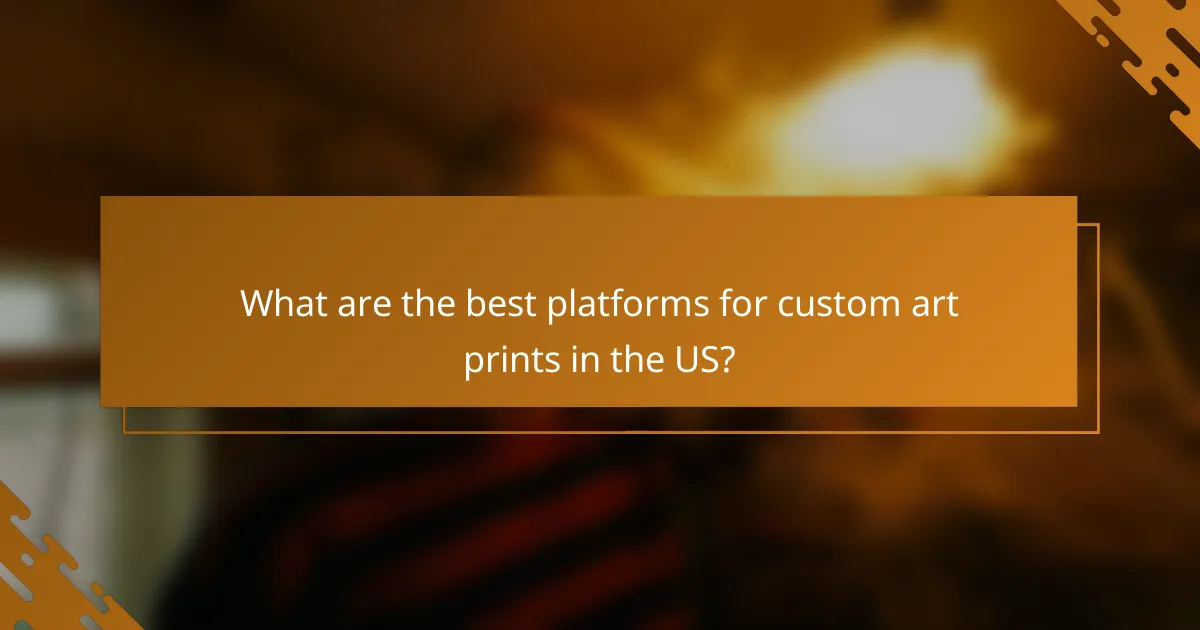
What are the best platforms for custom art prints in the US?
The best platforms for custom art prints in the US include Society6, Redbubble, and Fine Art America. Each offers unique features that cater to different artistic needs and preferences, making it easier to find the right fit for your custom art projects.
Society6 for unique designs
Society6 is known for its extensive collection of unique designs created by independent artists. The platform allows users to purchase art prints, home decor, and various products featuring these original artworks.
When using Society6, consider the variety of products available, from art prints to furniture. This diversity enables you to find art that complements your personal style while supporting emerging artists.
Redbubble for artist collaborations
Redbubble excels in artist collaborations, offering a platform where artists can upload their designs and sell them on various products. This community-driven approach allows for a wide range of creative expressions and styles.
When choosing Redbubble, look for the option to customize products with your favorite designs. This flexibility can lead to unique gifts or personal items that reflect your taste while promoting independent creators.
Fine Art America for high-quality prints
Fine Art America specializes in high-quality art prints, providing a marketplace for artists to sell their work. The platform is known for its focus on fine art and offers various print options, including canvas, framed, and metal prints.
When considering Fine Art America, pay attention to the quality of materials and printing techniques used. This ensures that your custom art prints will have a professional finish, making them suitable for display in any setting.

How to choose the right size for custom art prints?
Choosing the right size for custom art prints is crucial for achieving the desired aesthetic and fit in your space. Consider the dimensions of your wall and the overall design of the room to ensure the art complements your decor.
Standard size options
Standard size options for custom art prints typically include common dimensions such as 8×10 inches, 16×20 inches, and 24×36 inches. These sizes are widely available and can fit easily into standard frames, making them a convenient choice for many buyers.
When selecting a standard size, think about how the print will be displayed. For instance, larger prints can serve as focal points, while smaller ones may work better in a gallery wall arrangement.
Custom size specifications
Custom size specifications allow you to create art prints tailored to your specific needs. You can choose dimensions that perfectly fit your wall space, such as 12×18 inches or even larger sizes like 30×40 inches.
When opting for custom sizes, ensure that the resolution of your images is high enough to maintain quality at larger dimensions. A good rule of thumb is to have at least 300 DPI for prints to avoid pixelation.
Room size considerations
Room size plays a significant role in determining the appropriate size for your custom art prints. In smaller rooms, opt for smaller prints or a series of smaller pieces to avoid overwhelming the space. Conversely, larger rooms can accommodate bigger prints that draw attention.
Additionally, consider the furniture and layout of the room. Art prints should harmonize with the surrounding elements, so measure wall space and visualize how different sizes will interact with your decor before making a decision.
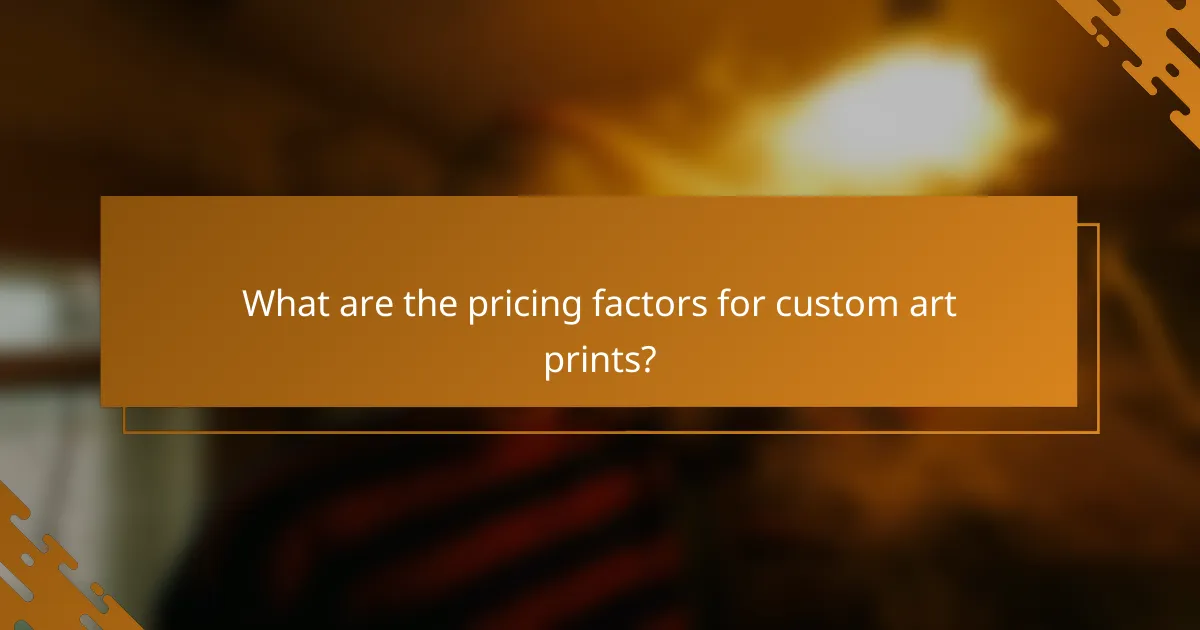
What are the pricing factors for custom art prints?
The pricing for custom art prints is influenced by several key factors, including material choices, print size, and production techniques. Understanding these elements can help you make informed decisions and manage your budget effectively.
Material cost variations
Material costs play a significant role in determining the overall price of custom art prints. Common materials include canvas, paper, and metal, each with varying price points. For instance, canvas prints typically range from moderate to high costs, while paper prints can be more affordable.
When selecting materials, consider the intended use and display environment. For example, outdoor displays may require weather-resistant materials, which can increase costs. Additionally, premium options like archival paper or specialty finishes can elevate the price but also enhance the print’s longevity and visual appeal.
To manage costs, compare different material options and their respective prices. A simple strategy is to request samples to evaluate quality before committing to larger orders. This way, you can balance quality with budget constraints effectively.
